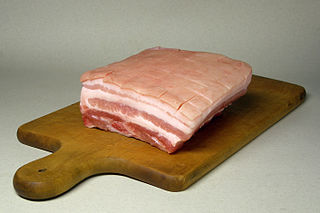
Louisiana Creole cuisine is a style of cooking originating in Louisiana, United States, which blends West African, French, Spanish, and Native American influences, as well as influences from the general cuisine of the Southern United States.

Puerto Rican cuisine consists of the cooking style and traditional dishes original to Puerto Rico. It has been primarily a fusion influenced by the ancestors of the Puerto Rican people: the indigenous Taínos, Spanish Criollos and sub-Saharan African slaves. As a territory of the United States, the culinary scene of Puerto Rico has also been moderately influenced by American cuisine.

Malaysian cuisine consists of cooking traditions and practices found in Malaysia, and reflects the multi-ethnic makeup of its population. The vast majority of Malaysia's population can roughly be divided among three major ethnic groups: Malays, Chinese and Indians. The remainder consists of the indigenous peoples of Sabah and Sarawak in East Malaysia, the Orang Asli of Peninsular Malaysia, the Peranakan and Eurasian creole communities, as well as a significant number of foreign workers and expatriates.

Latin American cuisine is the typical foods, beverages, and cooking styles common to many of the countries and cultures in Latin America. Latin America is a highly racially, ethnically, and geographically diverse with varying cuisines. Some items typical of Latin American cuisine include maize-based dishes arepas, empanadas, pupusas, tacos, tamales, tortillas and various salsas and other condiments. Sofrito, a culinary term that originally referred to a specific combination of sautéed or braised aromatics, exists in Latin American cuisine. It refers to a sauce of tomatoes, roasted bell peppers, garlic, onions and herbs. Rice, corn, pasta, bread, plantain, potato, yucca, and beans are also staples in Latin American cuisine.

Galbi (Korean: 갈비), kalbi, galbi-gui (갈비구이), or grilled ribs is a type of gui in Korean cuisine. "Galbi" is the Korean word for "rib", and the dish is usually made with beef short ribs. When pork spare ribs or another meat is used instead, the dish is named accordingly. Galbi is served raw, then cooked on tabletop grills usually by the diners themselves. The dish may be marinated in a sweet and savory sauce usually containing soy sauce, garlic, and sugar. Both non-marinated and marinated galbi are often featured in Korean barbecue. In Japan, this and many other dishes in Korean barbecue influenced yakiniku, a fusion cuisine that often makes use of galbi.

Adobo or adobar is the immersion of food in a stock composed variously of paprika, oregano, salt, garlic, and vinegar to preserve and enhance its flavor. The Portuguese variant is known as carne de vinha d'alhos. The practice, native to Iberia, was widely adopted in Latin America, as well as Spanish and Portuguese colonies in Africa and Asia.

Pork belly or belly pork is a boneless, fatty cut of pork from the belly of a pig. Pork belly is particularly popular in American, Swedish, Danish, Norwegian, Polish, Hispanic, Filipino, Chinese, Korean, Vietnamese, and Thai cuisine.

Chicharrón is a dish generally consisting of fried pork belly or fried pork rinds. Chicharrón may also be made from chicken, mutton, or beef.

Bistek, also known as bistek tagalog or karne frita, is a Filipino dish consisting of thinly-sliced beefsteak braised in soy sauce, calamansi juice, garlic, ground black pepper, and onions cut into rings. It is a common staple in the Tagalog and Western Visayan regions of the Philippines. It is eaten over white rice.

Peranakan cuisine or Nyonya cuisine comes from the Peranakans, descendants of early Chinese migrants who settled in Penang, Malacca, Singapore and Indonesia, inter-marrying with local Malays. In Baba Malay, a female Peranakan is known as a nonya, and a male Peranakan is known as a baba. The cuisine combines Chinese, Malay, Javanese, South Indian, and other influences.

Colombian cuisine is a culinary tradition of the six main regions within Colombia. Colombian cuisine varies regionally and is influenced by Indigenous Colombian, Spanish, and African cuisines, with a slight Arab influence in some regions.

Dominican cuisine is made up of Spanish, Indigenous Taíno, Middle Eastern, and African influences. The most recent influences in Dominican cuisine are from the British West Indies and China.

Haitian cuisine is a Creole cuisine that originates from a blend of several culinary styles that populated the western portion of the island of Hispaniola, namely African, French, indigenous Taíno, Spanish, and Arab influences. Haitian cuisine has some similarities with "criollo" cooking and similar to the rest of the Caribbean, but differs in several ways from its regional counterparts. Flavors are bold and spicy demonstrating African and French influences, with notable derivatives coming from native Taíno and Spanish techniques.

Venetian cuisine, from the city of Venice, Italy, or more widely from the region of Veneto, has a centuries-long history and differs significantly from other cuisines of northern Italy, and of neighbouring Austria and of Slavic countries, despite sharing some commonalities.

Ló͘-bah-pn̄g, also called bah-sò-pn̄g in southern Taiwan, or translated to minced pork rice in English, is a rice dish that is commonly seen throughout Taiwan and Southern Fujian, China. The flavor may vary from one region to another, but the basic ingredients remain the same: ground pork marinated and boiled in soy sauce served on top of steamed rice. It is a type of gaifan dish.

Fried pork dishes are found in numerous cuisines around the world. Known for its tenderness and versatility, pork often prepared by frying for the resultant crispy and savory succulence. Below is a list of just some notable national fried pork dishes.

Sabahan cuisine is a regional cuisine of Malaysia. As in the rest of Malaysian cuisine, Sabah food is based on staples such as rice with a great variety of other ingredients and different methods of food preparations due to the influence of the state's varied geography and indigenous cultures that were quite distinct from the regional cuisines of the Peninsular Malaysia. Sabah along with its neighbour of Sarawak is famous for their multi-ethnic population.

Indo cuisine is a fusion cooking and cuisine tradition, mainly existing in Indonesia and the Netherlands, as well as Belgium, South Africa and Suriname. This cuisine characterized of fusion cuisine that consists of original Indonesian cuisine with Eurasian-influences—mainly Dutch, also Portuguese, Spanish, French and British—and vice versa. Nowaday, not only Indo people consume Indo cuisine, but also Indonesians and Dutch people.


















